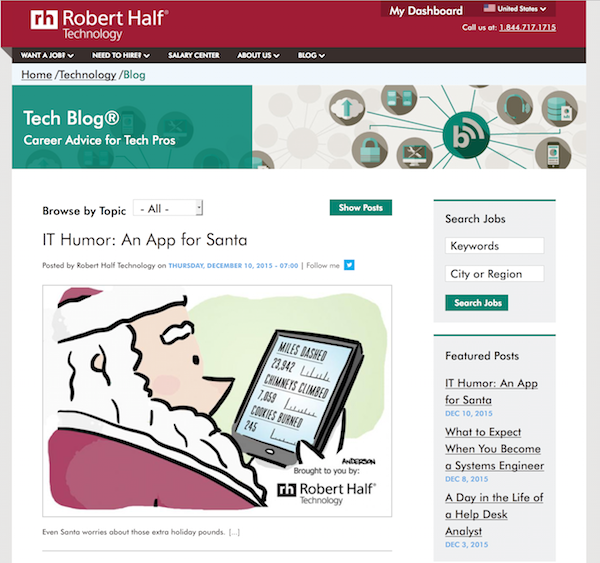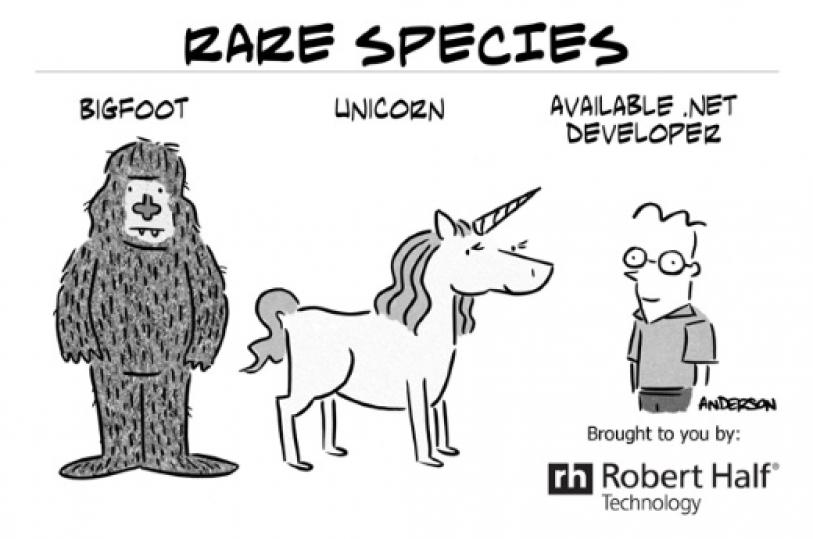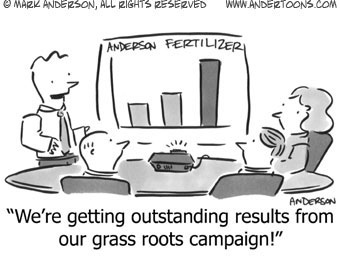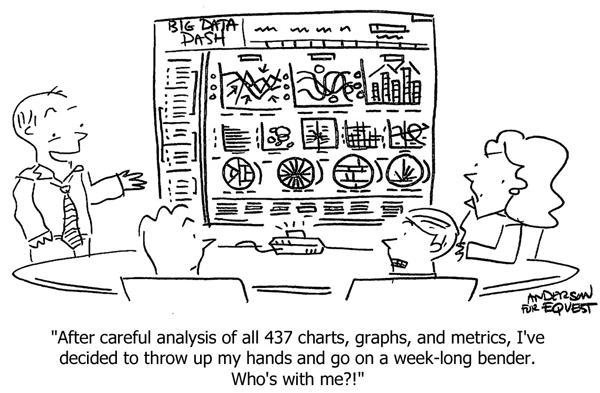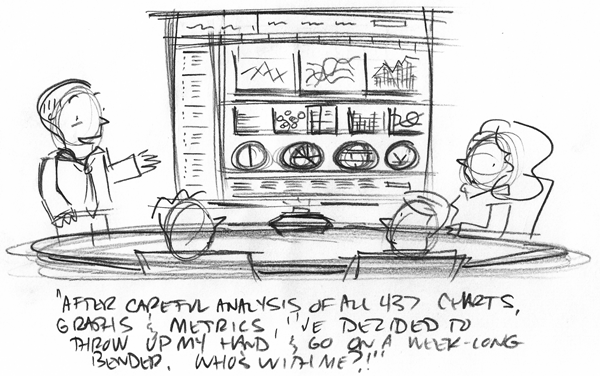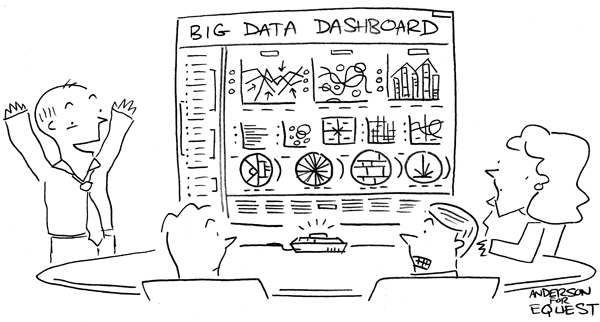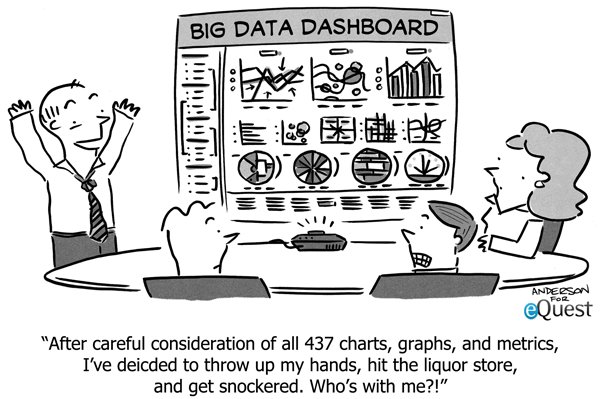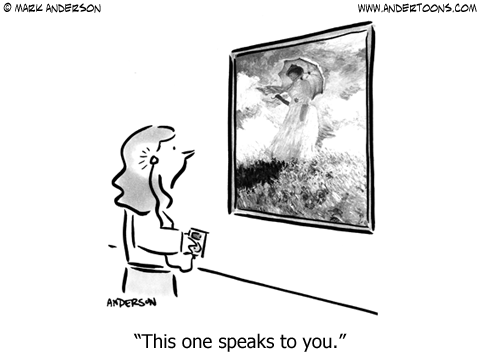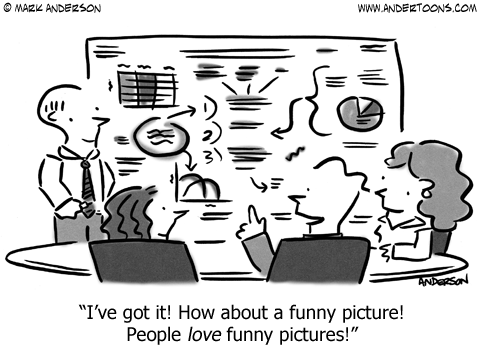I’ve written about custom cartoons and the creation process before, but I thought I’d go a little deeper this time and show you not only what I’d normally present to a client, but all of the extra behind-the-scenes work that people never see.
(Note – what follows is an actual example of one of the custom cartoons I’ve created for the good folks at eQuest. A big thanks to John and his crew for allowing me to use it here!)
Writing
It all starts with an initial idea from the client:
Person looking in utter frustration at an elongated computer screen with the term “Big Data Dashboard.” Screen should show an abundance of graphs, pie charts, a volcano blowing, fireworks, whatever…. Caption should read “NOW WHAT?”
He goes on to explain that the basic idea is…
“…that the dashboard contains WAY too much information to make a calculated decision. eQuest is developing non-dashboard like tools that make it extremely easy for users to utilize Big Data without actually realizing it. We want to make the point that you don’t need nifty looking dashboards to employ the use of statistical information.”
What happens next is I email over three or four ideas ideas to choose from. Here’s what I sent back:
1) Person looking at “Big Data Dashboard” on computer says to co-worker looking on – “This graph looks positive, the pie chart points to negative, but as for the animated hula girl or the spaceship, your guess is as good as mine.”
2) Frustrated employee looking over shoulder of frustrated co-worker at trying to make sense of over-complicated “Big Data Dashboard” on computer – “Try clicking on Bells, then go to the Whistles panel. After that you’re on your own.”
3) Big Data dashboard salesman looking at laptop with overwhelmed and confused potential client “It’s everything you need to know broken down into 37 bar graphs, superimposed onto 12 real-time line graphs, coordinated into 9 3-D pie charts. Now if you’d like to dig down…”
4) Disheveled manager to people in meeting looking at Big Data Dashboard being projected onto screen – “After careful consideration of all 437 charts, graphs, and metrics, I’ve decided to throw up my hands and go on a week-long bender. Who’s with me?!”
The client chose #4, but what he didn’t see were these additional ideas that I filtered out for various reasons:
a) Person looking at display showing large amount of confusing “Big Data” says to consultant – “I dunno, Tom, maybe we’ll stick with Little Data a while longer.”
This is sort of low-hanging fruit trading Little Data for Big Data. It’s too easy but it clears the way for better gags.
b) Giant laptop is menacing a city. Terrified resident points and yells “Oh no! It’s Big Data! RUN!”
It’s fun, but off topic. The client wants something that shows how confusing a crowded dashboard can be, not how scary Big Data can be.
c) Person in drive-thru is asked – “Would you like Big Data with that?”
I was thinking of Big Gulps, Biggie Fries, etc… Again, now it’s out of the way.
d) Consultant to overwhelmed client looking at massive amount of data on screen – “Oh, that’s just the Medium Data. We haven’t even gotten into Big Data yet.”
More playing on Big vs. other sizes. This is junk.
e) Person with glasses looking at screen crowded with massive amount of tiny info says to consultant – “For Big Data, that’s a pretty small font.”
OK, but it’s more a joke about legibility instead of content.
f) Consultant says to co-worker re: client who’s eyes are rolled up in his head and is drooling – “The bigger the Data, the harder they fall.”
Almost made the cut, but, again, it’s more about how Big Data can be overwhelming instead of confusing ways that Big Data can be presented.
I also came up with some weird half-ideas like a giant Data from Star Trek, something about a sack labelled “Bag Data,” and giant anthropomorphic numbers in a waiting room.
The point is, for every few ideas a client sees, there are usually 5-10 additional ideas that I don’t like and reject. I only want to present the very best I can come up with.
Sketches
So we’ve chosen the gag for our custom cartoon, which, after some additional back and forth, now reads:
“After careful analysis of all 437 charts, graphs, and metrics, I’ve decided to throw up my hands and go on a week-long bender. Who’s with me?!”
Next I draw up a pencil sketch so the client can get an idea of what the final cartoon could look like. Here’s what I sent over:
But what the client sees as the first sketch isn’t really my first take. Here’s the actual first sketch:
When I started doing custom cartoons, I’d have sent this over to a client. It looks OK, everything’s basically there, and the client should be able to see past any little imperfections, right?
Wrong. What I see in my mind’s eye with that rough sketch is totally different that what the client sees. Sure, a sketch like this saves me time at the drawing table, but it wastes the client’s time by asking them to interpret something that is incomplete. And, frankly, it also often makes them a little uncomfortable about my artistic abilities.
So I draw up another ‘clean sketch,’ and that’s what I present to a client. Here it is again:
The client liked the sketch and asked only for a few small changes – put the presenter’s arms up, and add “Big Data Dashboard” to the top of the screen. Can do.
Here’s the revised sketch:
So at this point I’m done, right? Not quite.
Research & Revise
A follow-up email from the client:
I showed it to several people – and don’t freak out – but I actually got people asking me what “bender” meant.
Am I getting old? Bender is a great word.
Changing it to a “…week-long drunk…” isn’t as good.
Thoughts?
My first thought is this is a really great client; he’s totally right, “bender” is great. But if it’s not as universal as it used to be, I need to come up with some options.
I could rattle off a few “drunk” synonyms off the top of my head, but custom cartoons can often hinge on just the right word, so I do my research.
Thesaurus.com offers up some good choices:
- Tipsy
- Crocked
- Lit
- Plastered
- Sloshed
- Tanked
- Three Sheets to the Wind
Not bad, but none of them are quite right. I try another source:
- Blotto
- Cucumbered
- Hammered
- Pie-eyed
- Wrecked
Good choices (especially “blotto”), but I still don’t have it. So I keep trying various sources until I finally come across what I think is the perfect word:
I run this new caption past the client:
“After careful analysis… I’ve decided to throw up my hands, hit the liquor store, and get snockered. Who’s with me?!”
It’s approved and I can move on to the final art.
Ink & Shade
When I ink I work quickly to keep the artwork looking like it was just dashed off. (Nothing kills the fun in a cartoon like a too-careful line that just lays there.) So as I go I write little notes to myself. Usually they’re things for me to fix in Photoshop or little reminders of what the client wanted:
- Use a font for the “Big Data Dashboard” at the top.
- Resize the second pie chart slightly to bring it in line with the others.
- Fix the eyebrow on the front right character from angry to surprised.
Then I scan in the ink and go to work in Photoshop.
I make my fixes and do the ink wash. I shade in Photoshop using scanned markers because it allows me to keep a more organic feel to the art, while giving me an Undo when I need it.
Final Art
Here’s a look at the final art the client received:
The scene and characters read cleanly, it gets the point across quickly, and it delivers a laugh all in about seven seconds. It’s a great addition to a blog post, but could also be used in to pep up a presentation, add some visual interest to a newsletter, or drive traffic via social media.
I retain a copy of all the custom cartoons I create as backups, but I also keep the Photoshop PSD broken into layers (ink, shade, text) in case the client needs to make changes in the future or wants a color version.
I try to keep the client’s experience in creating custom cartoons as easy and enjoyable as possible. And although it takes quite a bit of effort behind the scenes to pull that off, crafting something really great for the client and their audience is totally worth it.
If you’re tired of stock photos and infographics, you might give custom cartoons a try. They’re the perfect complement to your content.
FYI, here are some additional articles on custom cartoons:

